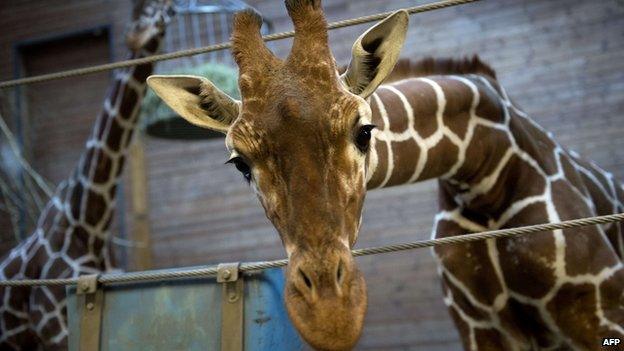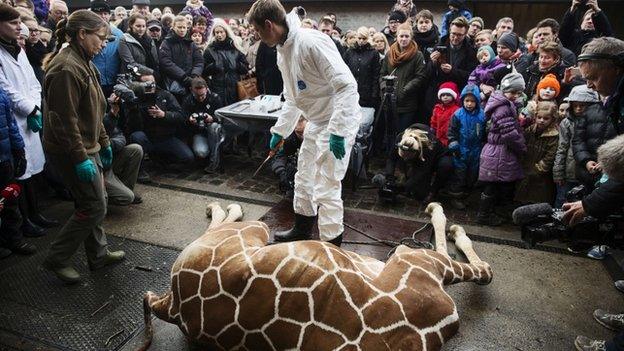'Surplus' giraffe put down at Copenhagen Zoo
- Published
Scientific director, Bengt Holst, insists the giraffe population must be kept "genetically sound"
A bid to save a young giraffe from destruction at Copenhagen Zoo has failed, and the giraffe was put down on Sunday morning.
Thousands of people had signed an online petition appealing for a change of heart over the two-year-old called Marius.
The zoo said it had no choice because of its duty to avoid in-breeding.
Marius was killed by a bolt gun, not a lethal injection, which would contaminate the meat.
A post-mortem examination was broadcast live on the internet.
A crowd of visitors, including children, watched as the carcass was skinned, cut up and fed to the lions.
A spokesman for the zoo told the Associated Press the event allowed parents to decide whether their children should watch.
"I'm actually proud because I think we have given children a huge understanding of the anatomy of a giraffe that they wouldn't have had from watching a giraffe in a photo," Stenbaek Bro told AP.
The zoo's scientific director, Bengt Holst, told the BBC he had received death threats but would not alter his style of animal management.

Several institutions had offered to house Marius before the giraffe was destroyed
The UK's Yorkshire Wildlife Park - which has a state-of-the-art giraffe house and the capacity for an extra male - was among several zoos which put in last-ditch offers to take Marius.
It said it was "saddened" by the killing of the animal.
'Good practice'
Stine Jensen, from Denmark's Organisation Against the Suffering of Animals, said the situation "should not have occurred".
"It just shows that the zoo is in fact not the ethical institution that it wants to portray itself as being, because here you have a waste product - that being Marius.
"Here we have a zoo which thinks that putting this giraffe down instead of thinking of alternatives is the best option," she said.
But Mr Holst defended Marius's destruction, saying that giraffes had to be selected to ensure the best genes were passed down to ensure the long-term survival of the species.
He told the BBC it was a responsible practice for zoos to manage their animal populations to ensure they remained healthy, with some 20-30 animals put down at Copenhagen Zoo in a typical year.
"Giraffes today breed very well, and when they do you have to choose and make sure the ones you keep are the ones with the best genes," Mr Holst told the BBC.
He said all zoos had been considered and there was no place for Marius - including at Yorkshire where, he said, any space should be reserved for a genetically more important giraffe. The campaign to save him, he said, had gone "much too far".
Animal rights campaigners have described the move as barbaric and have accused the zoo of being unethical.
The director of a wildlife park in the Netherlands, Robert Krijuff, whose last-minute offer of a place was also rejected, said: "I can't believe it. We offered to save his life. Zoos need to change the way they do business."

Visitors, including children, were invited to watch while the giraffe was dissected and fed to the lions
- Published7 February 2014
- Published28 August 2013
- Published21 September 2012